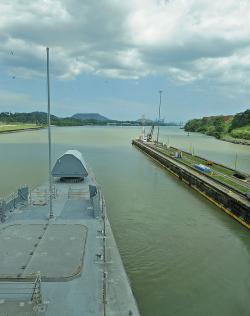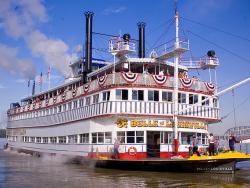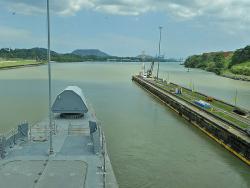The United States became interested in a water route through the Panamanian isthmus in the mid-1850s, but it was the French who first attempted to build the Panama Canal. Led by Ferdinand de Lesseps, builder of the Suez Canal in Egypt, the French began the project in 1876. Conditions were brutal: rampant yellow fever and malaria; massive landslides and flooding; sweltering heat; and construction equipment that was too light for the job.
1914

YearAdded:
Image Credit:
Courtesy Flickr/Naval Surface Warriors (CC BY-SA 2.0)
Image Caption:
Panama Canal
Era_date_from:
1914
1984

The Belle of Louisville, built in 1914, is the oldest operating “western rivers” steamboat. It has the shallow-draft flat-bottom hull braced by hog-chain trusses, multiple fire-tube boilers, paddlewheel propulsion, and superstructure configuration that were characteristic of hundreds of steamboats that plied America’s rivers during the 19th and 20th centuries
YearAdded:
Image Credit:
Courtesy Flickr/Bailey Visual Life (CC BY 2.0)
Image Caption:
Belle of Louisville, still in operation
Era_date_from:
1914
2010

This is the earliest known survivor of an integrated cotton ginning system widely used to process cotton from wagon to bale in a continuous operation. The gin machinery was designed and built in 1914 by the Lummus Cotton Gin Company. It can process seven bales per hour. Five gin stands, stick machine, burr machine, separators, cleaners, press pump, and pneumatic conveying fans are driven by a 125-hp Bessemer oil engine. This gin ran commercially until 1974 and was restored to operating condition in 1993.
YearAdded:
Image Credit:
Courtesy Flickr/John W. Schulze (CC BY 2.0)
Image Caption:
Burton Farmers Gin Mill
Era_date_from:
1914
1994

With a water table several feet below ground level, New Orleans faced a crisis after every heavy rainfall, not just through flooding but also through disease (yellow fever and malaria) caused by impure water. New Orleans was dependent on mechanical means for lifting water from its canals and sewage systems.
A. Baldwin Wood (1879-1956), a young assistant city engineer, designed and installed a system of large screw pumps (axial flow machines) to syphon water and accelerate drainage. By 1915 the Wood screw pump became the most advanced drainage pump in use.
YearAdded:
Image Credit:
Courtesy ASME
Image Caption:
This 14-foot tall Wood Screw Pump, constructed 1929, drained even more sewage/water/drainage than the 12-foot drains that preceded it
Era_date_from:
1914
1974

With a water table several feet below ground level, New Orleans faced a crisis after every heavy rainfall, not just through flooding but also through disease (yellow fever and malaria) caused by impure water. New Orleans was dependent on mechanical means for lifting water from its canals and sewage… Read More

This is the earliest known survivor of an integrated cotton ginning system widely used to process cotton from wagon to bale in a continuous operation. The gin machinery was designed and built in 1914 by the Lummus Cotton Gin Company. It can process seven bales per hour. Five gin stands, stick… Read More

The Belle of Louisville, built in 1914, is the oldest operating “western rivers” steamboat. It has the shallow-draft flat-bottom hull braced by hog-chain trusses, multiple fire-tube boilers, paddlewheel propulsion, and superstructure configuration that were characteristic of hundreds of steamboats… Read More

The United States became interested in a water route through the Panamanian isthmus in the mid-1850s, but it was the French who first attempted to build the Panama Canal. Led by Ferdinand de Lesseps, builder of the Suez Canal in Egypt, the French began the project in 1876. Conditions were brutal…
Read More

